La capacità di andare a indagare ciò che si nasconde oltre la realtà visibile, quella colta quotidianamente dall’occhio, ha generato negli artisti con questa particolare sensibilità intuitiva la necessità di tendere verso un linguaggio espressivo che fosse altrettanto sottile e al di sopra della contingenza, per indurre l’osservatore ad avvicinarsi in maniera istintiva alla tela, oltrepassando le barriere della ragione per entrare nel mondo dell’irrazionale, quello in grado però di condurre verso le profondità introspettive necessarie per porsi in ascolto di tutto ciò che appartiene all’interiorità. La scelta di armonizzare la sua inclinazione alla riflessione e alla crescita attraverso la consapevolezza e l’innalzamento della coscienza all’esigenza espressiva che sente appartenere alla sua natura, è quella compiuta dalla protagonista di oggi.
Non è possibile parlare di istinto, di impulso creativo e di libertà realizzativa senza fare riferimento all’Espressionismo Astratto, il movimento pittorico nato intorno alla metà degli anni Cinquanta del Ventesimo secolo che per primo introdusse il concetto della non regola, del rinunciare a ogni forma di limitazione o di gabbia stilistica che avrebbe privato l’artista della possibilità di lasciar fluire spontaneamente il suo sentire più profondo, quello che sarebbe divenuto messaggio comunicativo tra l’esecutore dell’opera e il ricevente, l’osservatore. Unico comun denominatore del movimento di cui Jackson Pollock fu uno dei fondatori, era appunto la necessità di far fuoriuscire le emozioni perché quel mondo interiore era stato troppo a lungo escluso dalle precedenti correnti astrattiste, come il De Stijl, il Costruttivismo, il Suprematismo, la Bauhaus, l’Astrattismo Geometrico, in cui l’approccio era più analitico e matematico, così tanto da escludere in maniera categorica ogni influenza soggettivistica sull’opera. Secondo la teoria degli espressionisti astratti invece l’opera d’arte non poteva prescindere dal mondo interiore, dalla soggettività che poteva rendere unico e indistinguibile lo stile di ciascun artista e dunque quella fu l’unica condizione per poter appartenere al gruppo in cui la pittura più impulsiva, come quella dell’Action Painting e del Dripping, coesistesse con un punto di osservazione più meditativo, più equilibrato e silenzioso manifestato attraverso il Color Field, che spesso tendeva verso la monocromia del Minimalismo, oppure la pittura segnica poteva appartenere allo stesso grande gruppo del colorato e vivace Tachisme; insomma, il comune denominatore doveva essere quello di esaltare al massimo l’indole espressiva dell’autore della tela. Persino all’interno della medesima tecnica si evidenziarono differenze sostanziali che sottolineano le differenti personalità degli artisti, come nel Color Field di Helen Frankenthaler, vivace, mescolato con il segno, sia coloristico che grafico, quasi come se il completamento e la sinergia fossero alla base della ricerca della realtà, ben diverso da quello di Mark Rothko, decisamente più moderato, equilibrato, suggestivo perché evocante il silenzio necessario all’artista per condurre la sua meditazione sull’ambiente circostante. L’artista olandese Karin Knevel in qualche modo riprende il Color Field di Helen Frankenthaler pur personalizzandolo secondo il suo sentire, lasciandosi andare a quel contatto con la propria interiorità che è stata frutto di un percorso di studio e di approfondimento attraverso cui è riuscita a trovare lo stile che più le calzasse, che fosse più affine alla sua nuova consapevolezza.
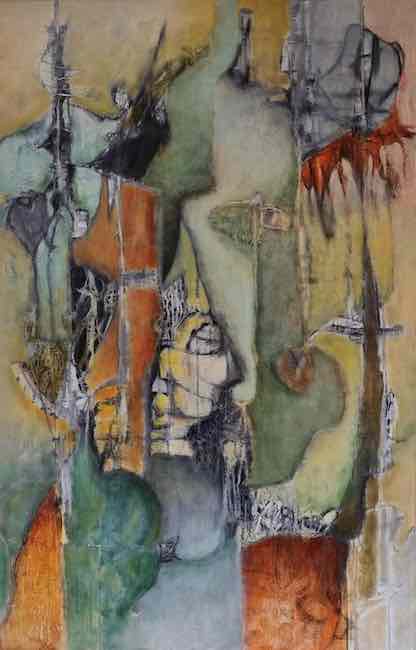
Dopo aver mosso i primi passi artistici nell’area figurativa, a seguito della scelta di seguire un corso per diventare terapeuta psicoenergetico ha compreso di non poter limitare la sua essenza creativa alla rappresentazione della realtà osservata, dei ritratti; così ha compiuto la scelta di abbandonare lo stile precedente e dare inizio a una fase di sperimentazione dove la sua creatività potesse armonizzarsi con l’esigenza di lasciar parlare il suo io più profondo, quello in grado di entrare in contatto con le energie circostanti in virtù delle quali riflettere e permettere ai concetti di divenire protagonisti delle sue opere, senza il limite dell’attinenza alla contingenza.
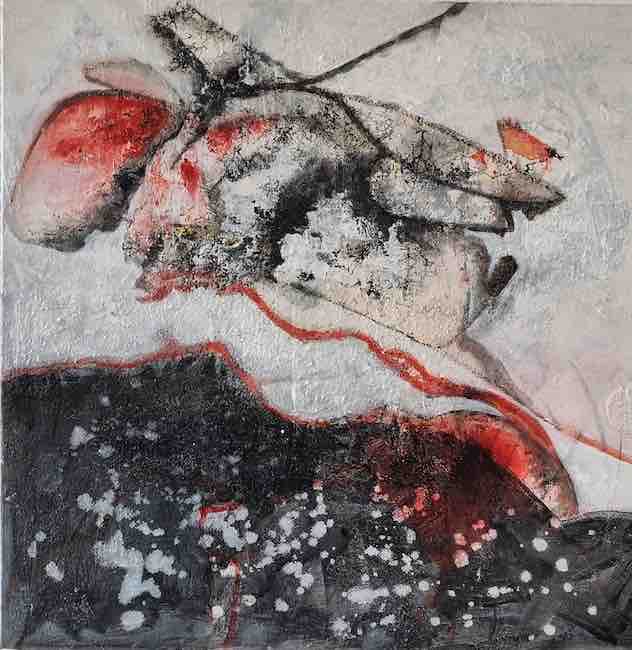
La gamma cromatica scelta da Karin Knevel è poliedrica proprio perché deve allinearsi al pensiero, alla sensazione, all’istante e anche al concetto di cui ha bisogno di narrare, come se la sua esigenza interiore chiedesse di determinare la struttura e l’aspetto finale della tela, non solo dal punto di vista delle tonalità bensì persino da quello dell’interazione tra tecniche differenti che nelle sue opere si sovrappongono e si mescolano dando origine a una costante ricerca dell’armonia perfetta tra il sentire e il comunicare.
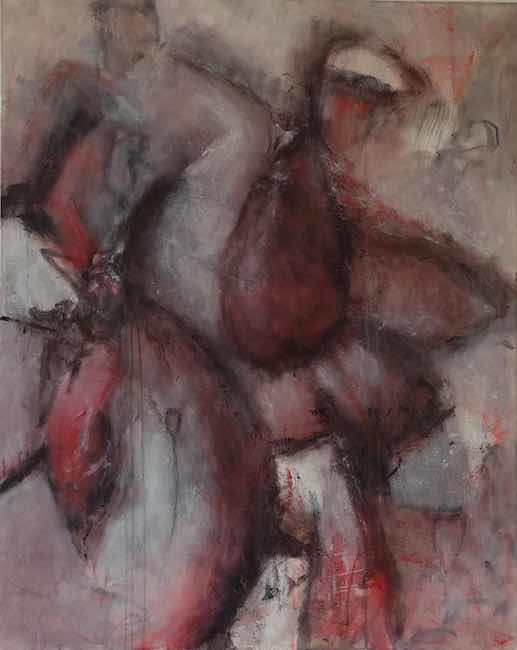
Le sue tele sono una sinergia perfetta tra acrilico, inchiostro, pastelli a olio, pennarelli a china, penne a punta, matite inktense, Faber Castell Gelatos, matite Stabilo All, legni, pastelli morbidi, tutti dettagli funzionali a permetterle di incidere sulla tela il suo mondo più profondo, la sensibilità che raggiunge la massima espressione quando la Knevel è in contatto con la natura, con quella bellezza silenziosa in grado di aprire i canali energetici e indurre la mente a connettersi con l’anima per intraprendere un percorso di approfondimento della conoscenza di sé. Lo sguardo interiore dell’artista si perde in un mondo spirituale, in una dimensione in cui non è importante ciò che viene colto attraverso l’immagine, piuttosto è l’interpretazione che viene data dalla mente quando è coesa con l’essenza più profonda a emergere e divenire protagonista delle sue opere.
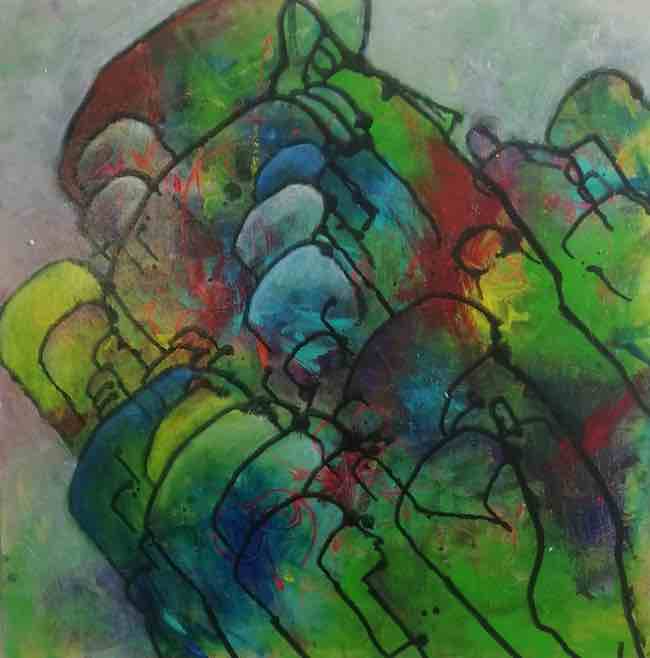
Nella tela How Many Personalities Are You (Quante personalità hai) Karin Knevel esplora tutto quel mondo sommerso troppo spesso tenuto a bada dalla razionalità che compone il complesso puzzle della personalità di ciascun individuo, malgrado la società contemporanea tenda a far emergere un solo lato ben determinato e definito, quasi come se accettare le sfaccettature e convivere con esse costituisse una possibilità da temere. Secondo l’analisi compiuta dall’artista invece la coesistenza e l’autocoscienza della poliedricità che contraddistingue ciascun essere umano, quello libero che non ha paura di mostrarsi mutevole e soggetto a tutti i cambiamenti e trasformazioni che fanno inevitabilmente parte del percorso di ciascuno, possono dar vita a un’essenza più ricca, più completa e decisamente più serena proprio in virtù dell’accettazione di sé. L’inchiostro sottolinea le sfaccettature tanto quanto il colore di base sottostante evidenzia l’appartenenza alla medesima natura.
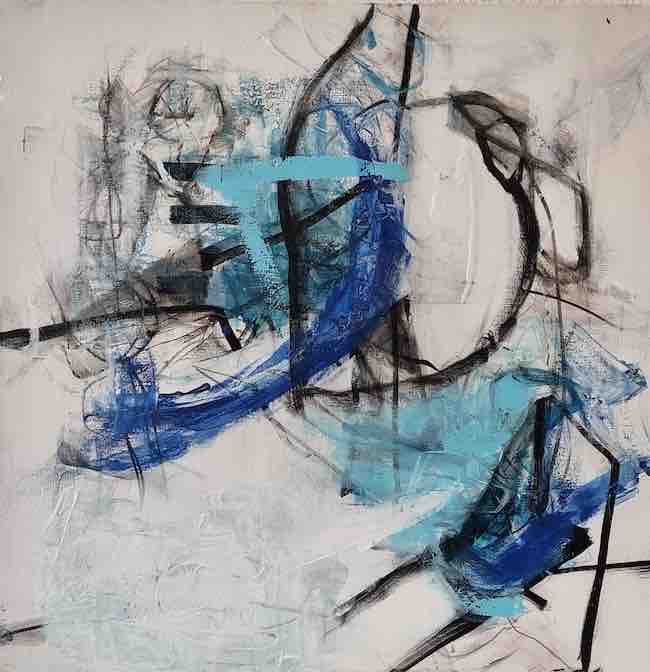
Nel dipinto Orderlineness (Ordinabilità) la Knevel sembra voler mettere in evidenza quanto inutile sia cercare di delimitare i confini o governare gli accadimenti, tentativi espressi dalle linee grafiche nere, davanti a un’esistenza, sia umana che universale, completamente dominata dal caos, quello buono, quello funzionale a imparare a lasciarsi andare agli insegnamenti e alle conoscenze che proprio dal disordine dell’inaspettato, e dalla propria capacità di gestire l’imprevisto e le conseguenze del cambiamento, derivano. Non esiste evoluzione senza forze opposte, non esiste ordine senza una precedente destabilizzazione, non esiste certezza senza la tendenza a metterla in discussione.
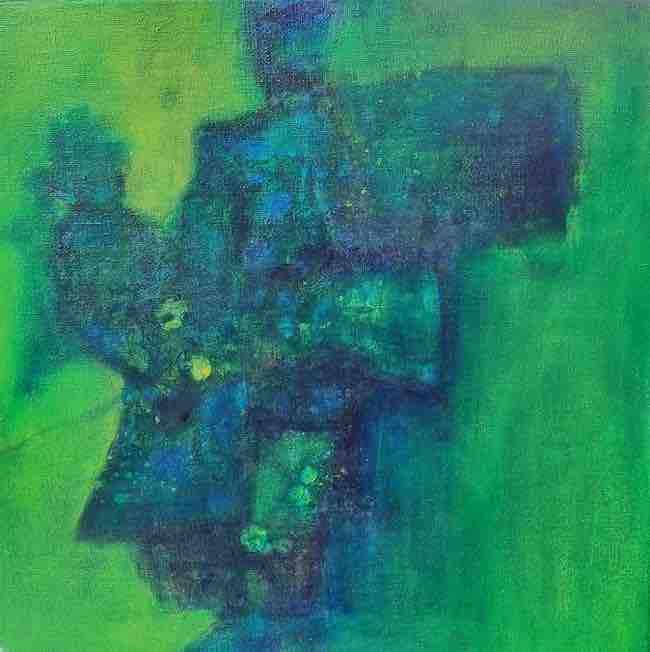
Karin Knevel si addentra nella destabilizzazione quasi volontariamente, come se il suo porsi delle domande dovesse riflettersi anche sull’osservatore perché spesso è proprio chi è più inconsapevole ad aver bisogno di mettersi in dubbio, di sgretolare le proprie certezze e porsi quesiti che l’arte stimola spontaneamente, senza troppe parole che metterebbero in azione la logica; questo è l’approccio che emerge dall’opera What Could It Be (Cosa potrebbe essere), un invito da parte dell’artista ad attivare la propria intuitività emozionale per dare una propria interpretazione a quel Color Field in scala di verde, il colore dell’abbondanza, del fluire verso l’individuo di quelle energie che spingono ad aprirsi a tutto ciò che sopraggiunge, all’amore incondizionato. E nella domanda si nasconde in qualche modo la risposta che spesso non si è capaci di trovare perché troppo condizionati dalla contingenza per prestare ascolto alla positività di ciò che ruota intorno a sé.
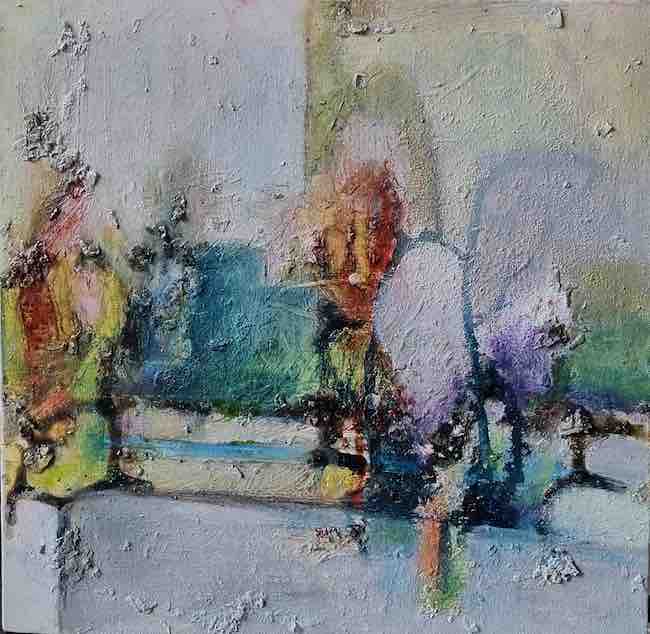
E così Karin Knevel stimola l’immaginazione, sollecita l’interpretazione dell’osservatore semplicemente lasciando fuoriuscire la sua essenza, il suo punto di vista, come in Fantasy Landscape (Paesaggio di fantasia), un luogo immaginario dentro cui riconoscersi, dove cercare ciascuno il proprio riferimento che però appartiene alla memoria emotiva, perché è lì che è possibile ritrovare se stessi. Karin Knevel ha alle spalle un lungo percorso artistico, fatto di studio e di continua sperimentazione del suo lato creativo in armonia con tecniche che ama studiare e mescolare; non ha ancora esposto al pubblico le sue opere ma intende cominciare un percorso espositivo sia in Olanda che all’estero.
KARIN KNEVEL-CONTATTI
Email: ART-LANTIS@hotmail.com
Facebook: https://www.facebook.com/profile.php?id=100083224148363
Instagram: https://www.instagram.com/karinknevel/
Psychological insights and energies of the soul in Karin Knevel’s Abstract Expressionism
The ability to investigate what is hidden beyond visible reality, that which is caught daily by the eye, has generated in artists with this particular intuitive sensibility the need to tend towards an expressive language that is just as subtle and above contingency, to induce the observer to approach the canvas instinctively, going beyond the barriers of reason to enter the world of the irrational, the one that can however lead towards the introspective depths necessary to listen to all that belongs to interiority. The choice to harmonise her inclination towards reflection and growth through awareness and the raising of consciousness with the expressive need she feels belongs to her nature is the one made by today’s protagonist.
It is impossible to speak of instinct, creative impulse and freedom of realisation without referring to Abstract Expressionism, the pictorial movement born around the mid-1950s that first introduced the concept of non-rules, of renouncing any form of limitation or stylistic cage that would have deprived the artist of the possibility of letting his deepest feelings flow spontaneously, the one that would have become a communicative message between the executor of the artwork and the receiver, the observer. The only common denominator of the movement, of which Jackson Pollock was one of the founders, was precisely the need to let the emotions flow out because that inner world had been excluded for too long by previous abstractist currents, such as De Stijl, Constructivism, Suprematism, Bauhaus, and Geometric Abstractionism, in which the approach was more analytical and mathematical, so as to categorically exclude any subjective influence on the work of art. According to the theory of the Abstract Expressionists, on the other hand, the artwork could not disregard the inner world, the subjectivity that could make each artist’s style unique and indistinguishable, and therefore that was the only condition for belonging to the group in which the more impulsive painting such as Action Painting and Dripping, coexisted with a more meditative, more balanced and silent point of view manifested through the Colour Field, which often tended towards the monochrome of Minimalism, or sign painting could belong to the same large group as the colourful and lively Tachisme; in short, the common denominator had to be that of enhancing the expressive nature of the author of the canvas to the utmost. Even within the same technique, there were substantial differences that underlined the different personalities of the artists, as in Helen Frankenthaler’s Colour Field, lively, mixed with sign, both colouristic and graphic, almost as if completion and synergy were at the basis of the search for reality, quite different from Mark Rothko’s, decidedly more moderate, balanced, suggestive because it evoked the silence necessary for the artist to conduct the meditation on his surroundings.
The Dutch artist Karin Knevel in some ways takes up Helen Frankenthaler’s Colour Field while personalising it according to her feelings, letting herself go to that contact with her own interiority that was the fruit of a path of study and deepening through which she managed to find the style that best suited her, that was most akin to her new awareness. After taking her first artistic steps in the figurative area, following her choice to follow a course to become a psycho-energetic therapist, she realised that she could not limit her creative essence to the representation of observed reality, of portraits; so she made the choice to abandon her previous style and begin a phase of experimentation where her creativity could harmonise with the need to let her deepest self speak, the one able to come into contact with the surrounding energies by virtue of which she could reflect and allow concepts to become the protagonists of her works, without the limitation of relevance to contingency. The chromatic range chosen by Karin Knevel is multifaceted precisely because it must align with the thought, the sensation, the instant and also the concept she needs to narrate, as if her inner need demanded that she determine the structure and final appearance of the canvas, not only from the point of view of tonality but even from that of the interaction between different techniques that in her paintings overlap and mix, giving rise to a constant search for the perfect harmony between feeling and communicating.
Her canvases are a perfect synergy of acrylic, ink, oil pastels, Indian ink markers, pointed pens, inktense pencils, Faber Castell Gelatos, Stabilo All pencils, woods, soft pastels, all details instrumental in allowing her to engrave her deepest world on canvas, a sensitivity that reaches its highest expression when Karin Knevel is in contact with nature, with that silent beauty capable of opening up energy channels and inducing the mind to connect with the soul in order to embark on a path of deepening self-knowledge. The artist’s inner gaze is lost in a spiritual world, in a dimension where it is not important what is captured through the image, rather it is the interpretation given by the mind when it is cohesive with the deepest essence that emerges and becomes the protagonist of her paintings. In the canvas How many personalities are you, Karin Knevel explores all that submerged world all too often kept at bay by rationality that makes up the complex puzzle of each individual’s personality, despite the fact that contemporary society tends to bring out only one well-determined and defined side, almost as if accepting the facets and living with them constituted a possibility to be feared. Instead, according to the artist’s analysis, the coexistence and self-awareness of the multifacetedness that characterises each human being, the free one who is not afraid to show himself mutable and subject to all the changes and transformations that are inevitably part of everyone’s journey, can give rise to a richer, more complete and decidedly more serene essence precisely by virtue of self-acceptance.
The ink emphasises facets as much as the underlying base colour emphasises belonging to the same nature. In the painting Orderlineness, Karin Knevel seems to want to highlight how futile it is to try to delimit boundaries or govern events, attempts expressed by the black graphic lines, in the face of an existence, both human and universal, completely dominated by chaos, the good kind, the kind to learn to let go of the teachings and knowledge that derive precisely from the disorder of the unexpected, and from one’s ability to manage the unexpected and the consequences of change. There is no evolution without opposing forces, no order without previous destabilisation, no certainty without the tendency to question it. Karin Knevel delves into destabilisation almost voluntarily, as if her questioning should also be reflected on the observer, because it is often those who are most unaware who need to question themselves, to crumble their own certainties and ask themselves questions that art stimulates spontaneously, without too many words that would put logic into action; this is the approach that emerges from the canvas What could it be, an invitation on the part of the artist to activate the emotional intuitiveness in order to give one’s own interpretation to that green-scaled Colour Field, the colour of abundance, of the flowing towards the individual of those energies that drive one to open up to everything that comes along, to unconditional love. And in the question is somehow hidden the answer that we are often unable to find because we are too conditioned by contingency to listen to the positivity of what revolves around us. And so Karin Knevel stimulates the imagination, solicits the observer’s interpretation by simply allowing his essence, his point of view, to emerge, as in Fantasy Landscape, an imaginary place within which to recognise oneself, where each of us can look for his own reference that belongs to the emotional memory, because it is there that one can find oneself. Karin Knevel has a long artistic career behind her, made up of study and continuous experimentation of her creative side in harmony with techniques she loves to study and mix; she has not yet exhibited her artworks to the public but intends to begin an exhibition path both in the Netherlands and abroad.














